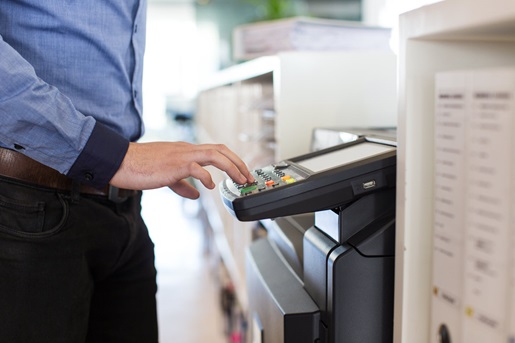Printing legal documents comes with some specific considerations, from build quality to feature set
In the law, precision is everything. Even a small misprint can jeopardize the legality of a contract. It’s critical that these offices maintain that precision across the scores of pages they print every day. But it isn’t always easy. The volume and sensitivity of these documents demand special consideration. Plus, they often use legal-size pages that are bigger than the standard copy page.
Not every printer can meet these demands. That’s why law offices seek out specific features in their legal printers. From advanced security to efficient paper handling, these are the factors to consider when buying a printer for your practice.
Looking for a printer to meet your industry’s unique needs? Check out our guide, Business Printing Solutions: Which Printer Fits Your Industry? for more information.
Key considerations for legal printers
Dedicated or multifunction
The first decision a law office needs to make when buying a printer is between dedicated printers and all-in-one (AIO) devices. These multifunction machines combine printing, scanning, copying, and faxing in a single footprint. That can make them a very convenient solution. AIOs take up less space than a dedicated scanner and printer. And they’re often less expensive than buying two devices.
But AIOs have downsides, too. For one, these devices can only perform one of their functions at a time. That can cause backups in your workflow. So can a malfunction in any part of the devices, as you’ll likely lose all functionality until that part is fixed.
Additionally, for AIOs to keep their prices low, they often have to compromise on one or another component. That leads to AIOs that print more slowly or scan less accurately than their dedicated counterparts. In an increasingly digital business environment, scanning functionality is more important than ever.
Versatile paper handling
Paper handling refers to how a printer moves pages from input to output, adding text and images along the way. A well-designed printer uses precise engineering to keep things working smoothly over years of use. Paper handling also encompasses the ability to handle a variety of paper sizes, making it critical when buying printers that print legal size paper.
Legal printers should be capable of printing both letter paper (8.5 inches by 11 inches) and legal paper (8.5x14). While printers that print legal size paper are fairly common, not every AIO will function as a legal size paper scanner printer. If you choose an AIO, make sure it has both a multifunction tray that fits 8.5-inch by 14-inch paper and a scanning bed large enough for legal paper.
Having discrete input trays for each of these sizes can avoid misuse of one or the other in printing jobs, which saves on materials long-term. So does duplex (or double-sided) printing. If you plan to use one size of paper more than the other, having at least one high-capacity input tray can avoid print job interruptions.
Durable design
Law offices print a huge volume of paper. To meet that demand, they need legal printers made for the long haul. The more sturdy a printer, the fewer breakdowns and jams it should encounter. Fewer disruptions mean less downtime and less downtime means more productivity. Plus, tougher printers usually require less maintenance and last longer, saving you money on maintenance and replacements.
To get a sense of how durable a printer will be, examine its duty cycle. The duty cycle is a ballpark figure of how many pages a printer can print in a month without issue. Most laser printers have duty cycles between 20,000 and 40,000. These numbers aren’t foolproof, as different manufacturers measure them using different methods. But they can give you an idea of a printer’s maximum capacity.
Of course, duty cycles are the upper bound for a printer. To maintain peak performance for as long as possible, manufacturers often also provide recommended monthly print volumes. These numbers are roughly 5%-10% of the duty cycle. Printing to that limit rather than the duty cycle will help your printer last longer.
Did You Know?:The RICOH 132 multi-function printer can also copy, scan, and fax — all in a compact frame. Click here to learn more.
Rapid printing
If you and your team are constantly waiting for print jobs to finish, you likely need a faster printer. Legal printers should be able to print at very high speeds to avoid work bottlenecks. The two most common printing technologies are inkjet and laser. Inkjet printers average 5–20 pages per minute — pretty fast, but not as fast as laser printers. Laser printers can output 20-40 pages per minute. Laser printers also benefit from producing completely dry pages. Inkjet pages, meanwhile, can smudge if they aren’t given time to dry.
Exact precision
Smudges aren’t such a big deal when printing at home. But in a legal context, legibility is paramount. A smudge in the wrong place can make a contract or filing void, undoing hours of work.
To ensure your prints come out as precise as possible, consider two factors. The first: dots per inch (DPI). DPI measures printer resolution, with 300 DPI as the standard. It’s a good idea to avoid printers with a DPI under 300, but DPIs over 600 are intended for photos. With text, the extra detail is hard to notice.
The second factor to consider is the laser vs. inkjet divide. Inkjet printers must move much more slowly to achieve the same precision as laser printers. Plus, ink takes a long time to dry, which makes it vulnerable to smudging. Laser printers dry instantaneously, allowing for very precise fonts and lettering.
Low cost per page
Sticker price is just one part of a printer’s cost. Over time, you’ll have to replace its ink or toner cartridges. The longer each cartridge lasts, the less each page it prints costs in real terms. As a result, it’s often more cost-effective to buy a more expensive printer that uses cartridges efficiently. Especially if your printer is durable enough to last for several years.
Manufacturers don’t always provide a cost per page number. But savvy buyers can find one themselves by comparing the cartridge price against its page yield. Inkjet cartridges can produce around 220 pages before they need to be replaced. Laser printers, meanwhile, can squeeze 2,500-4,000 pages out of each cartridge. That leads most inkjet printers toward a cost per page of $0.05-$0.10, and laser printers to one below $0.05.
Advanced security
Legal documents can include a lot of sensitive information. Whether it’s protecting client privacy or respecting legal requirements, that info needs to stay private. As a result, law offices must pay special attention to security. Every device connected to the internet is a potential access point for bad actors. That includes your printer.
To keep sensitive data safe, look for printers with security features. Access controls such as RFID-enabled keycard readers can prevent in-person misuse. But network security may be even more important. Transport Layer Security (TLS) 1.3 encrypts data during transit to keep it secure. Also important: easy firmware and software updates. These updates keep your security on the leading edge, so the easier they are to apply, the safer your printers will be.
Did You Know?:The RICOH 132 P printer offers speedy and precise duplex printing on legal paper and letter paper. Click here to learn more.
Our recommendation: RICOH Printer 132 P
Drawing on more than 50 years of experience, RICOH designed the 132 P to meet the rigorous standards of modern business. The 132 P packs tons of value into a compact physical footprint. It boasts a 250-page input tray (plus a 50-page multifunction tray) and blazes through 32 double-sided pages per minute with crystal-clear, smudge-free text and fonts. Its duty cycle of 35,000 pages and its 3,500-page toner cartridges help you save in the long term, and it uses TLS 1.3 technology to keep your data safe. Click here to learn more.
Note: Information and external links are provided for your convenience and for educational purposes only, and shall not be construed, or relied upon, as legal or financial advice. PFU America, Inc. makes no representations about the contents, features, or specifications on such third-party sites, software, and/or offerings (collectively “Third-Party Offerings”) and shall not be responsible for any loss or damage that may arise from your use of such Third-Party Offerings. Please consult with a licensed professional regarding your specific situation as regulations may be subject to change.






